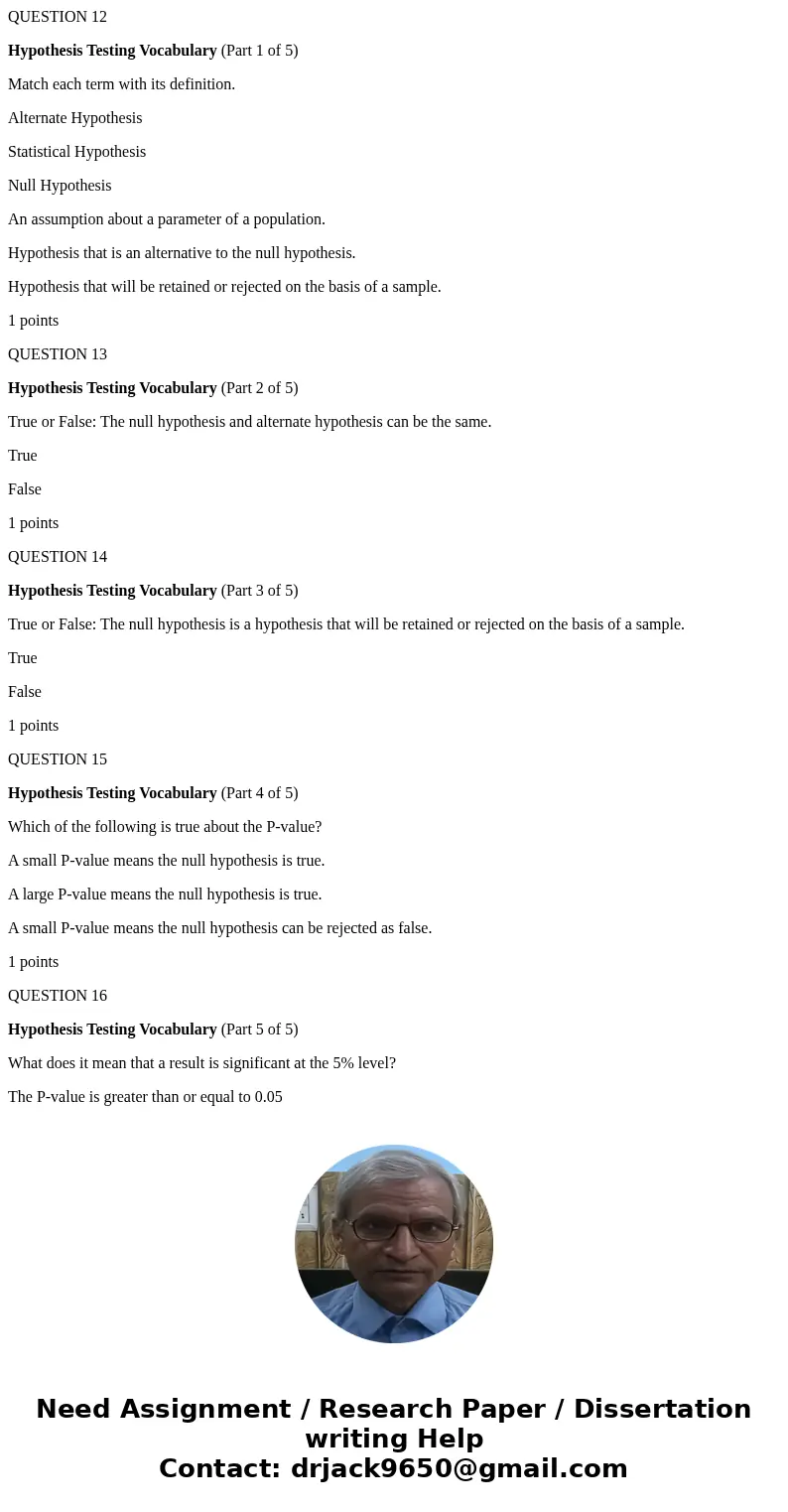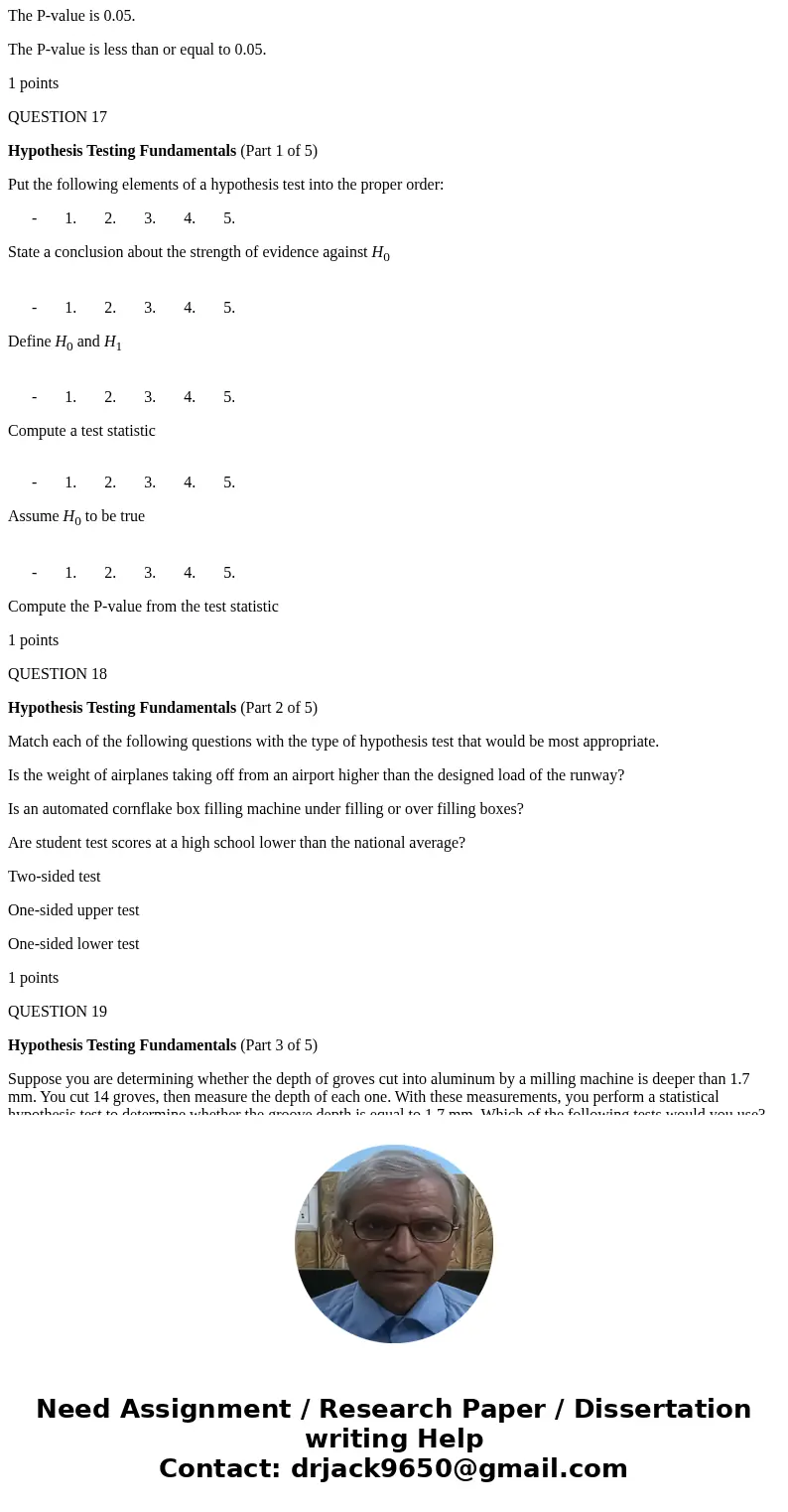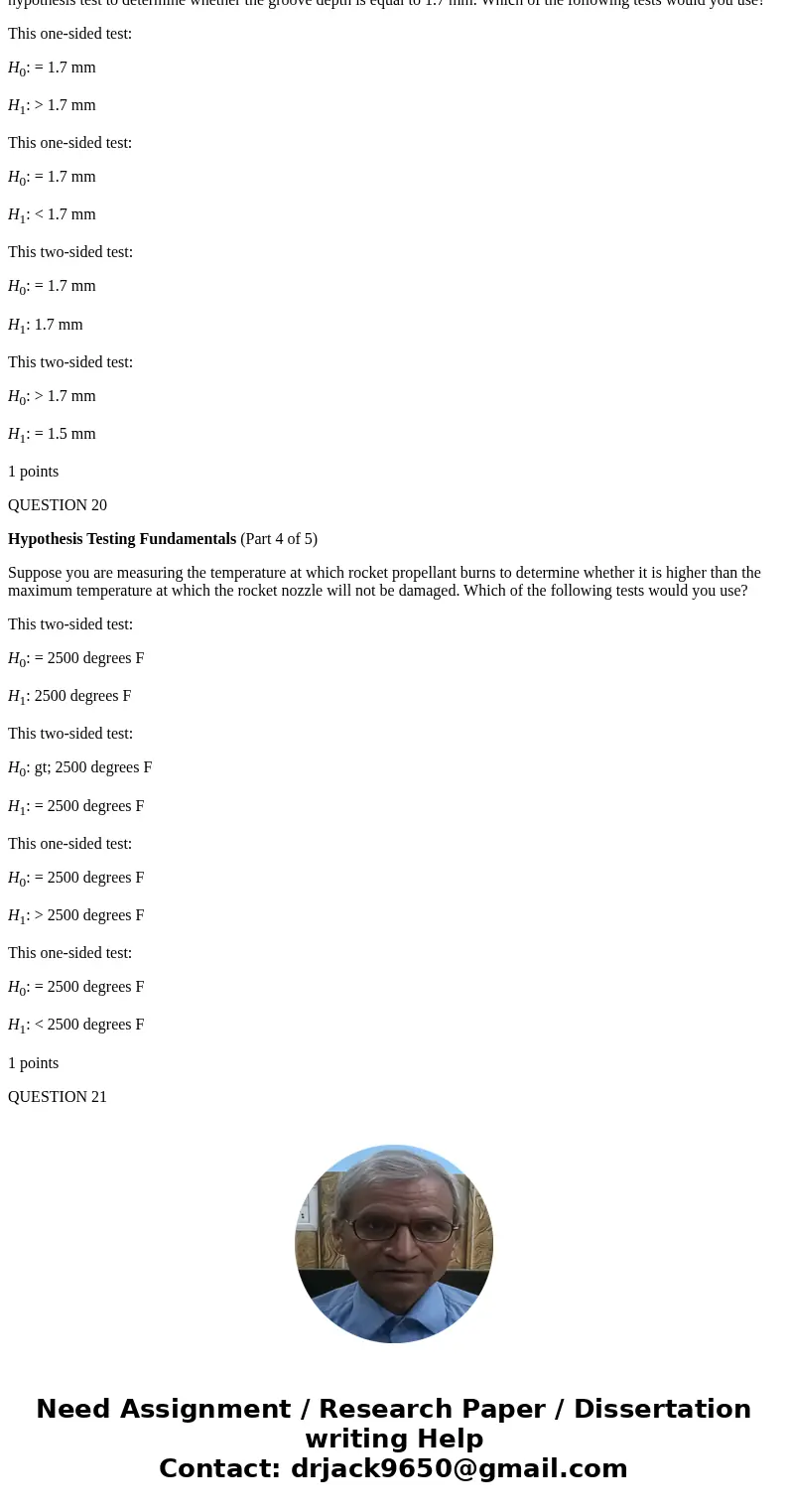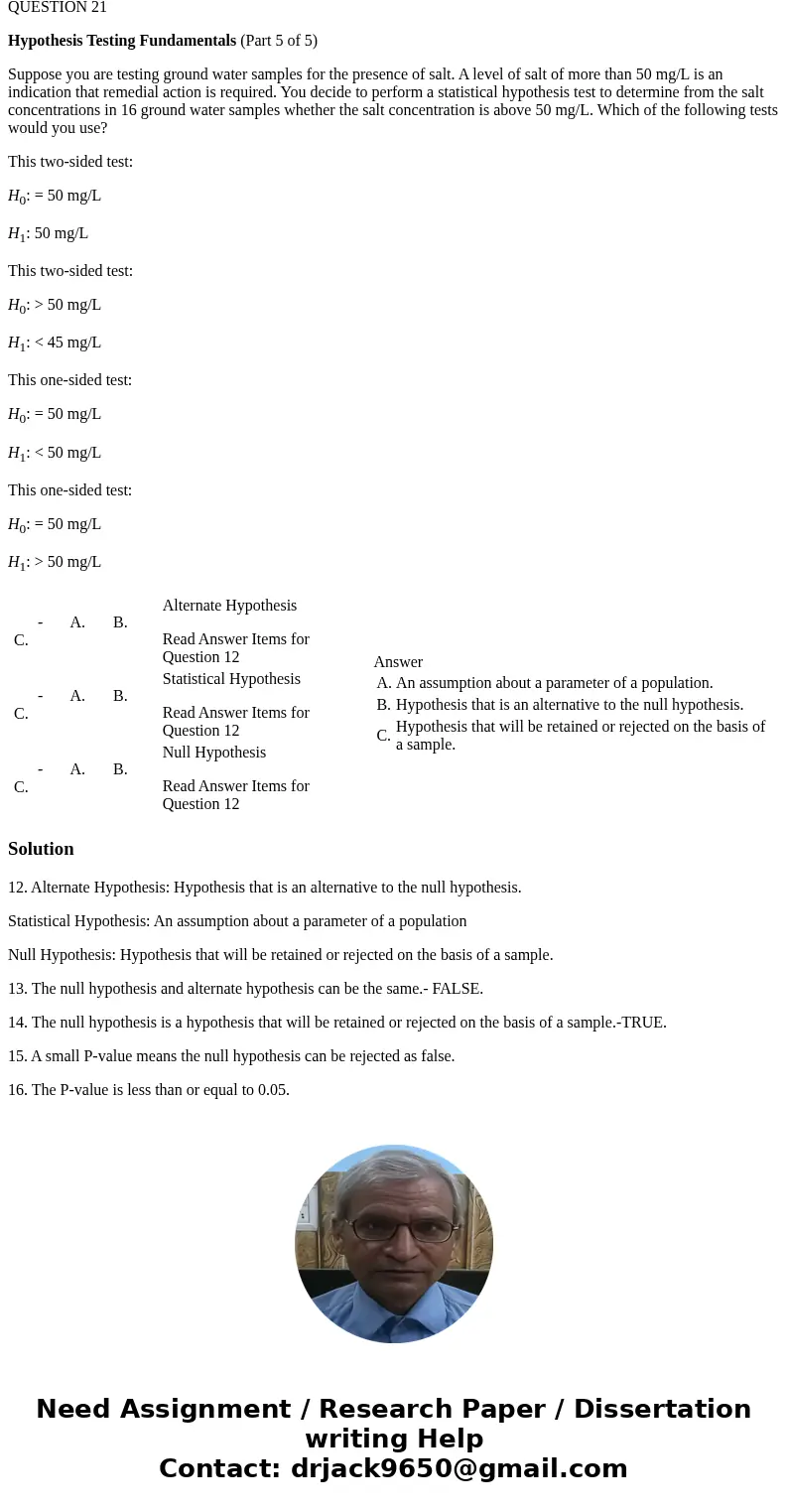QUESTION 12 Hypothesis Testing Vocabulary Part 1 of 5 Match
QUESTION 12
Hypothesis Testing Vocabulary (Part 1 of 5)
Match each term with its definition.
Alternate Hypothesis
Statistical Hypothesis
Null Hypothesis
An assumption about a parameter of a population.
Hypothesis that is an alternative to the null hypothesis.
Hypothesis that will be retained or rejected on the basis of a sample.
1 points
QUESTION 13
Hypothesis Testing Vocabulary (Part 2 of 5)
True or False: The null hypothesis and alternate hypothesis can be the same.
True
False
1 points
QUESTION 14
Hypothesis Testing Vocabulary (Part 3 of 5)
True or False: The null hypothesis is a hypothesis that will be retained or rejected on the basis of a sample.
True
False
1 points
QUESTION 15
Hypothesis Testing Vocabulary (Part 4 of 5)
Which of the following is true about the P-value?
A small P-value means the null hypothesis is true.
A large P-value means the null hypothesis is true.
A small P-value means the null hypothesis can be rejected as false.
1 points
QUESTION 16
Hypothesis Testing Vocabulary (Part 5 of 5)
What does it mean that a result is significant at the 5% level?
The P-value is greater than or equal to 0.05
The P-value is 0.05.
The P-value is less than or equal to 0.05.
1 points
QUESTION 17
Hypothesis Testing Fundamentals (Part 1 of 5)
Put the following elements of a hypothesis test into the proper order:
- 1. 2. 3. 4. 5.
State a conclusion about the strength of evidence against H0
- 1. 2. 3. 4. 5.
Define H0 and H1
- 1. 2. 3. 4. 5.
Compute a test statistic
- 1. 2. 3. 4. 5.
Assume H0 to be true
- 1. 2. 3. 4. 5.
Compute the P-value from the test statistic
1 points
QUESTION 18
Hypothesis Testing Fundamentals (Part 2 of 5)
Match each of the following questions with the type of hypothesis test that would be most appropriate.
Is the weight of airplanes taking off from an airport higher than the designed load of the runway?
Is an automated cornflake box filling machine under filling or over filling boxes?
Are student test scores at a high school lower than the national average?
Two-sided test
One-sided upper test
One-sided lower test
1 points
QUESTION 19
Hypothesis Testing Fundamentals (Part 3 of 5)
Suppose you are determining whether the depth of groves cut into aluminum by a milling machine is deeper than 1.7 mm. You cut 14 groves, then measure the depth of each one. With these measurements, you perform a statistical hypothesis test to determine whether the groove depth is equal to 1.7 mm. Which of the following tests would you use?
This one-sided test:
H0: = 1.7 mm
H1: > 1.7 mm
This one-sided test:
H0: = 1.7 mm
H1: < 1.7 mm
This two-sided test:
H0: = 1.7 mm
H1: 1.7 mm
This two-sided test:
H0: > 1.7 mm
H1: = 1.5 mm
1 points
QUESTION 20
Hypothesis Testing Fundamentals (Part 4 of 5)
Suppose you are measuring the temperature at which rocket propellant burns to determine whether it is higher than the maximum temperature at which the rocket nozzle will not be damaged. Which of the following tests would you use?
This two-sided test:
H0: = 2500 degrees F
H1: 2500 degrees F
This two-sided test:
H0: gt; 2500 degrees F
H1: = 2500 degrees F
This one-sided test:
H0: = 2500 degrees F
H1: > 2500 degrees F
This one-sided test:
H0: = 2500 degrees F
H1: < 2500 degrees F
1 points
QUESTION 21
Hypothesis Testing Fundamentals (Part 5 of 5)
Suppose you are testing ground water samples for the presence of salt. A level of salt of more than 50 mg/L is an indication that remedial action is required. You decide to perform a statistical hypothesis test to determine from the salt concentrations in 16 ground water samples whether the salt concentration is above 50 mg/L. Which of the following tests would you use?
This two-sided test:
H0: = 50 mg/L
H1: 50 mg/L
This two-sided test:
H0: > 50 mg/L
H1: < 45 mg/L
This one-sided test:
H0: = 50 mg/L
H1: < 50 mg/L
This one-sided test:
H0: = 50 mg/L
H1: > 50 mg/L
| Answer
|
Solution
12. Alternate Hypothesis: Hypothesis that is an alternative to the null hypothesis.
Statistical Hypothesis: An assumption about a parameter of a population
Null Hypothesis: Hypothesis that will be retained or rejected on the basis of a sample.
13. The null hypothesis and alternate hypothesis can be the same.- FALSE.
14. The null hypothesis is a hypothesis that will be retained or rejected on the basis of a sample.-TRUE.
15. A small P-value means the null hypothesis can be rejected as false.
16. The P-value is less than or equal to 0.05.




 Homework Sourse
Homework Sourse